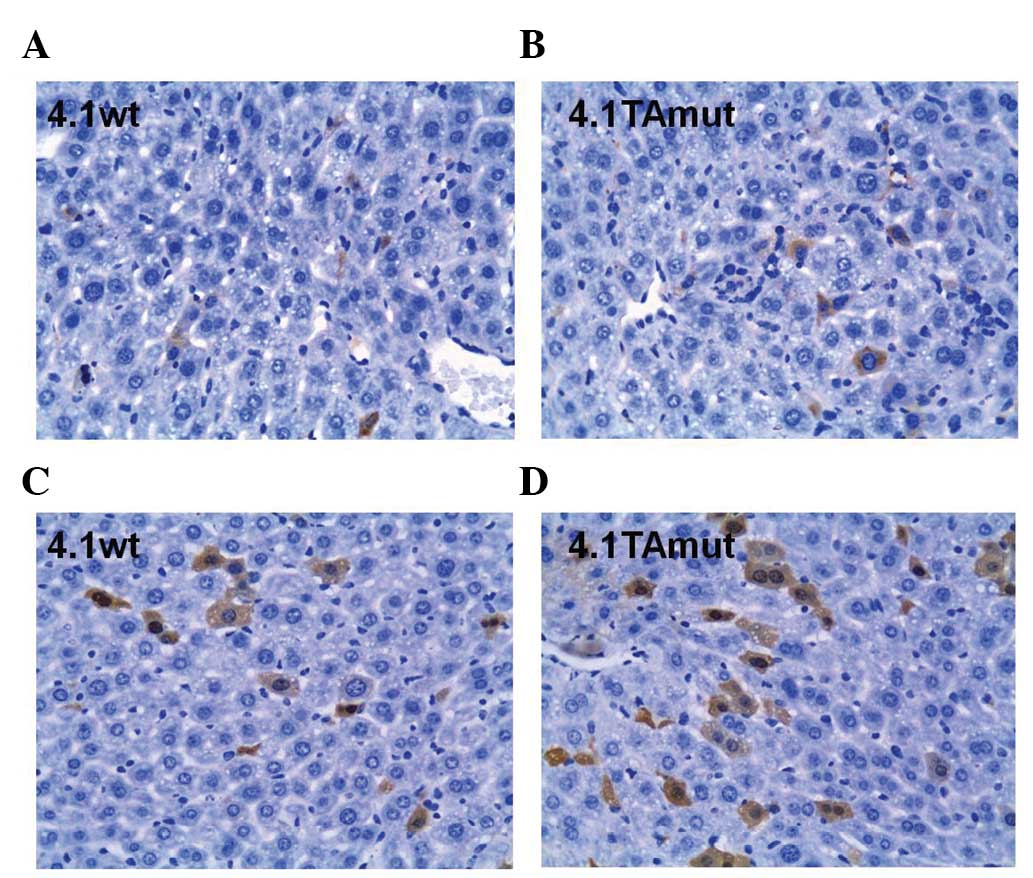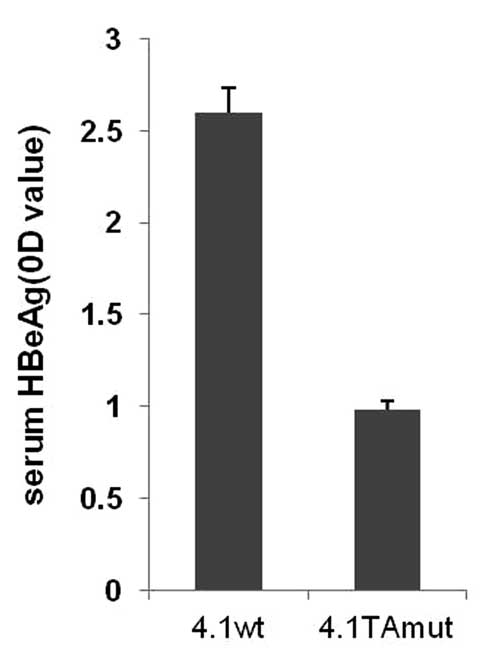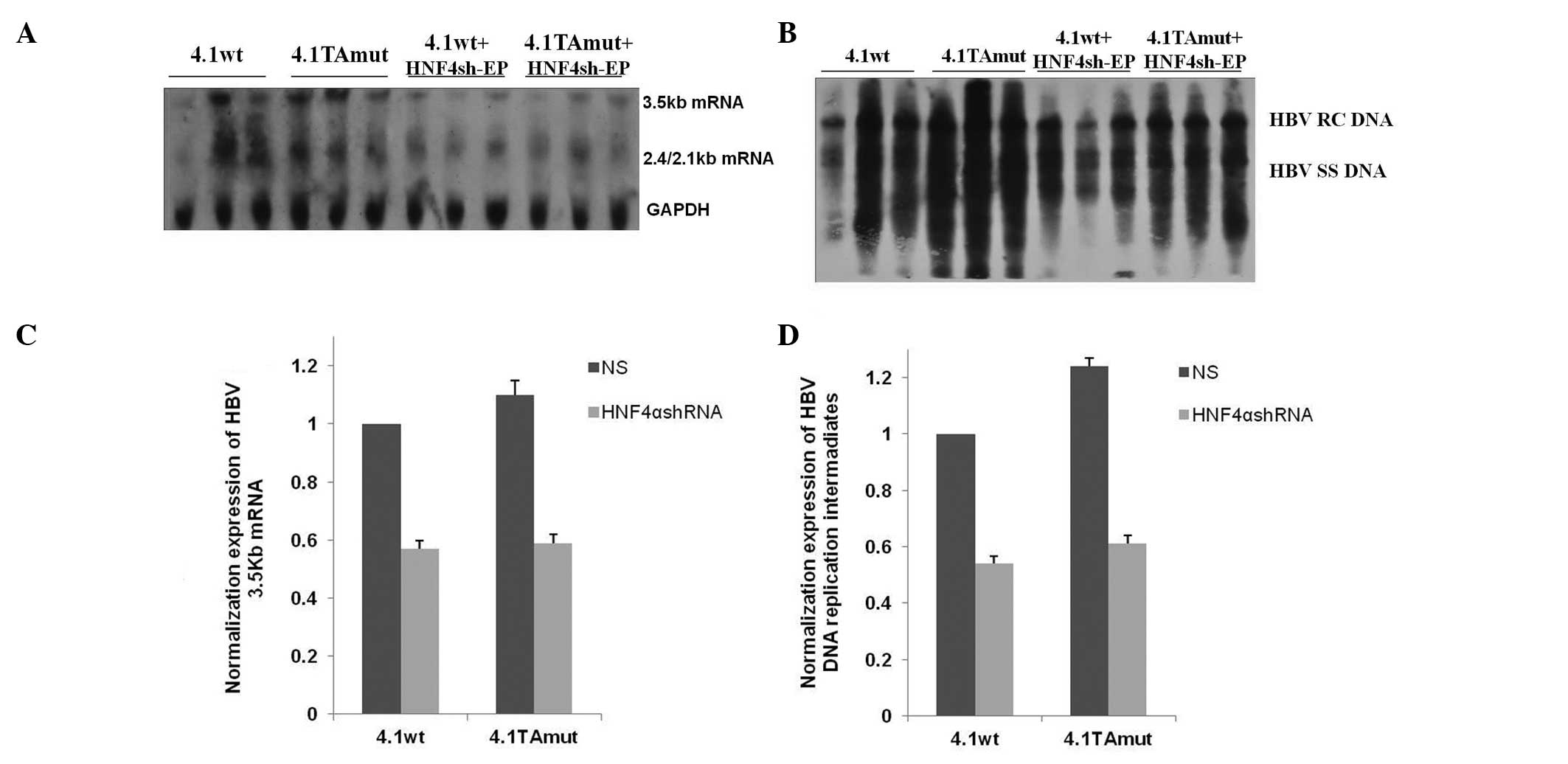|
1
|
Dandri M, Lutgehetmann M and Petersen J:
Experimental models and therapeutic approaches for HBV. Semin
Immunopathol. 35:7–21. 2013. View Article : Google Scholar
|
|
2
|
Tacke F, Gehrke C, Luedde T, Heim A, Manns
MP and Trautwein C: Basal core promoter and precore mutations in
the hepatitis B virus genome enhance replication efficacy of
Lamivudine-resistant mutants. J Virol. 78:8524–8535. 2004.
View Article : Google Scholar : PubMed/NCBI
|
|
3
|
Gunther S, Piwon N and Will H: Wild-type
levels of pregenomic RNA and replication but reduced pre-C RNA and
e-antigen synthesis of hepatitis B virus with C (1653)→ T, A
(1762)→ T and G (1764)→ A mutations in the core promoter. J Gen
Virol. 79:375–380. 1998. View Article : Google Scholar
|
|
4
|
Laras A, Koskinas J and Hadziyannis SJ: In
vivo suppression of precore mRNA synthesis is associated with
mutations in the hepatitis B virus core promoter. Virology.
295:86–96. 2002. View Article : Google Scholar : PubMed/NCBI
|
|
5
|
Li J, Buckwold VE, Hon MW and Ou JH:
Mechanism of suppression of hepatitis B virus precore RNA
transcription by a frequent double mutation. J Virol. 73:1239–1244.
1999.PubMed/NCBI
|
|
6
|
Parekh S, Zoulim F, Ahn SH, et al: Genome
replication, virion secretion and e antigen expression of naturally
occurring hepatitis B virus core promoter mutants. J Virol.
77:6601–6612. 2003. View Article : Google Scholar : PubMed/NCBI
|
|
7
|
Nelson PK, Mathers BM, Cowie B, et al:
Global epidemiology of hepatitis B and hepatitis C in people who
inject drugs: results of systematic reviews. Lancet. 378:571–583.
2011. View Article : Google Scholar : PubMed/NCBI
|
|
8
|
Lavanchy D: Hepatitis B virus
epidemiology, disease burden, treatment and current and emerging
prevention and control measures. J Viral Hepat. 11:97–107. 2004.
View Article : Google Scholar : PubMed/NCBI
|
|
9
|
Maynard JE: Hepatitis B: Global importance
and need for control. Vaccine. 8(Suppl): S18–S23. 1990. View Article : Google Scholar : PubMed/NCBI
|
|
10
|
Tseng TC, Liu CJ, Chen CL, et al: Serum
hepatitis B virus-DNA levels correlate with long-term adverse
outcomes in spontaneous hepatitis B e antigen seroconverters. J
Infect Dis. 205:54–63. 2012. View Article : Google Scholar
|
|
11
|
Chu CJ, Keeffe EB, Han SH, et al:
Prevalence of HBV precore/core promoter variants in the United
States. Hepatology. 38:619–628. 2003. View Article : Google Scholar : PubMed/NCBI
|
|
12
|
Ouneissa R, Bahri O, Alaya-Bouafif NB, et
al: Frequency and clinical significance of core promoter and
precore region mutations in Tunisian patients infected chronically
with hepatitis B. J Med Virol. 84:1719–1726. 2012. View Article : Google Scholar : PubMed/NCBI
|
|
13
|
Will H, Reiser W, Weimer T, et al:
Replication strategy of human hepatitis B virus. J Virol.
61:904–911. 1987.PubMed/NCBI
|
|
14
|
Sladek FM, Zhong WM, Lai E and Darnell JE
Jr: Liver-enriched transcription factor HNF-4 is a novel member of
the steroid hormone receptor superfamily. Genes Dev. 4:2353–2365.
1990. View Article : Google Scholar : PubMed/NCBI
|
|
15
|
Wang Z, Bishop EP and Burke PA: Expression
profile analysis of the inflammatory response regulated by
hepatocyte nuclear factor 4α. BMC genomics. 12:1282011. View Article : Google Scholar
|
|
16
|
Chen EQ, Sun H, Feng P, et al: Study of
the expression levels of Hepatocyte nuclear factor 4 alpha and 3
beta in patients with different outcome of HBV infection. Virol J.
9:232012. View Article : Google Scholar : PubMed/NCBI
|
|
17
|
Xu L, Chen EQ, Lei J, et al:
Pre-core/basal-core promoter and reverse transcriptase mutations in
chronic HBV infected-patients. Hepatogastroenterology. 59:212–215.
2012.PubMed/NCBI
|
|
18
|
Buckwold VE, Xu Z, Chen M, Yen TS and Ou
JH: Effects of a naturally occurring mutation in the hepatitis B
virus basal core promoter on precore gene expression and viral
replication. J Virol. 70:5845–5851. 1996.PubMed/NCBI
|
|
19
|
Liu FJ, Liu L, He F, et al: Establishment
and primary application of a mouse model with hepatitis B virus
replication. World J Gastroenterol. 13:5324–5330. 2007. View Article : Google Scholar : PubMed/NCBI
|
|
20
|
Tang H and McLachlan A: A pregenomic RNA
sequence adjacent to DR1 and complementary to epsilon influences
hepatitis B virus replication efficiency. Virology. 303:199–210.
2002. View Article : Google Scholar : PubMed/NCBI
|
|
21
|
Liu F, Song Y and Liu D:
Hydrodynamics-based transfection in animals by systemic
administration of plasmid DNA. Gene Ther. 6:1258–1266. 1999.
View Article : Google Scholar : PubMed/NCBI
|
|
22
|
Tang H, Delgermaa L, Huang F, et al: The
transcriptional transactivation function of HBx protein is
important for its augmentation role in hepatitis B virus
replication. J Virol. 79:5548–5556. 2005. View Article : Google Scholar : PubMed/NCBI
|
|
23
|
Chen EQ, Gong DY, Leng XH, et al:
Inhibiting the expression of hepatocyte nuclear factor 4 alpha
attenuates lipopolysaccharide/D-galactosamine-induced fulminant
hepatic failure in mice. Hepatobiliary Pancreat Dis Int.
11:624–629. 2012. View Article : Google Scholar : PubMed/NCBI
|
|
24
|
Ganem D and Prince AM: Hepatitis B virus
infection-natural history and clinical consequences. N Engl J Med.
350:1118–1129. 2004. View Article : Google Scholar : PubMed/NCBI
|
|
25
|
Sumi H, Yokosuka O, Seki N, et al:
Influence of hepatitis B virus genotypes on the progression of
chronic type B liver disease. Hepatology. 37:19–26. 2003.
View Article : Google Scholar
|
|
26
|
Pungpapong S, Kim WR and Poterucha JJ:
Natural history of hepatitis B virus infection: An update for
clinicians. Mayo Clin Proc. 82:967–975. 2007. View Article : Google Scholar : PubMed/NCBI
|
|
27
|
Tang H, Raney AK and McLachlan A:
Replication of the wild type and a natural hepatitis B virus
nucleocapsid promoter variant is differentially regulated by
nuclear hormone receptors in cell culture. J Virol. 75:8937–8948.
2001. View Article : Google Scholar : PubMed/NCBI
|
|
28
|
Yu H, Zhu R, Zhu YZ, Chen Q and Zhu HG:
Effects of mutations in the X gene of hepatitis B virus on the
virus replication. Acta virologica. 56:101–110. 2012. View Article : Google Scholar : PubMed/NCBI
|
|
29
|
Kim do Y, Kim HJ, Lee CK, et al: Efficacy
of adefovir dipivoxil in the treatment of lamivudine-resistant
hepatitis B virus genotype C infection. Liver Int. 27:47–53.
2007.PubMed/NCBI
|
|
30
|
Okamoto H, Tsuda F, Akahane Y, et al:
Hepatitis B virus with mutations in the core promoter for an e
antigen-negative phenotype in carriers with antibody to e antigen.
J Virol. 68:8102–8110. 1994.PubMed/NCBI
|
|
31
|
Scaglioni PP, Melegari M and Wands JR:
Biologic properties of hepatitis B viral genomes with mutations in
the precore promoter and precore open reading frame. Virology.
233:374–381. 1997. View Article : Google Scholar : PubMed/NCBI
|
|
32
|
Kim DW, Lee SA, Hwang ES, Kook YH and Kim
BJ: Naturally occurring precore/core region mutations of hepatitis
B virus genotype C related to hepatocellular carcinoma. PloS one.
7:e473722012. View Article : Google Scholar : PubMed/NCBI
|
|
33
|
Seeger C and Mason WS: Hepatitis B virus
biology. Microbiol Mol Biol Rev. 64:51–68. 2000. View Article : Google Scholar : PubMed/NCBI
|
|
34
|
Dai J, Chen EQ, Bai L, et al: Biological
characteristics of the rtA181T/sW172* mutant strain of Hepatitis B
virus in animal model. Virol J. 9:2802012. View Article : Google Scholar
|
|
35
|
Selabe SG, Song E, Burnett RJ and
Mphahlele MJ: Frequent detection of hepatitis B virus variants
associated with lamivudine resistance in treated South African
patients infected chronically with different HBV genotypes. J Med
Virol. 81:996–1001. 2009. View Article : Google Scholar : PubMed/NCBI
|
|
36
|
Koklu S, Tuna Y, Gulsen MT, et al:
Long-term efficacy and safety of lamivudine, entecavir and
tenofovir for treatment of hepatitis B virus-related cirrhosis.
Clin Gastroenterol Hepatol. 11:88–94. 2013. View Article : Google Scholar
|
|
37
|
Su W and T H: Regulation of hepatitis B
virus transcription and replication by liver-enriched
transcriptional factors. World Chinese Journal of Digestology.
15:1237–1240. 2007.
|















